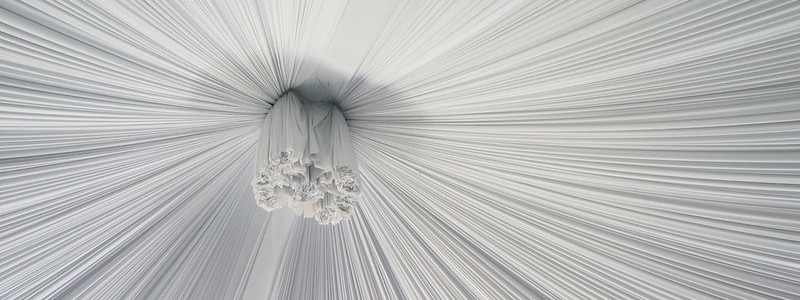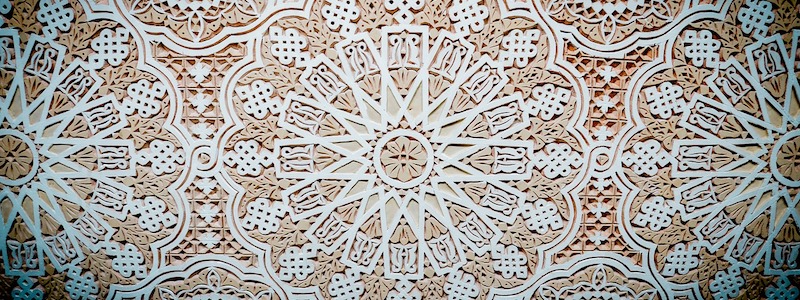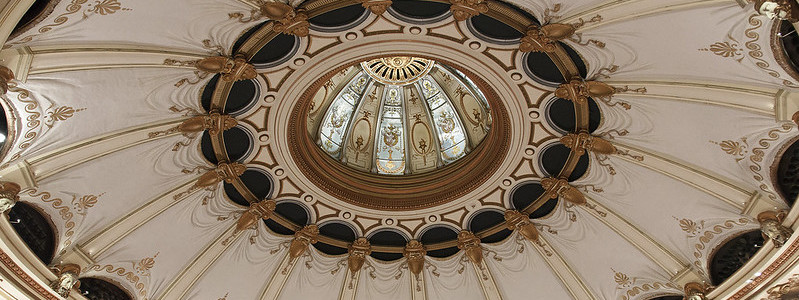Dropped ceiling - what exactly is a stretch ceiling?
Repairing an old, damaged ceiling might cost too much money and effort. In such a case you might consider a dropped ceiling to conceal the imperfections. An increasingly popular solution of this type is stretch ceiling. It is much more lightweight than plasterboard. It also allows for a quicker installation. Fabric ceiling is an alternative that is worth considering.

What is a stretch ceiling?
Stretch ceiling is a kind of dropped ceiling. This method is one of the oldest techniques in the category of interior design. Hanging a fabric under ceiling was popular in many countries throughout the centuries. Ancient Romans used silk, Egyptians - flax, while Armenians preferred cotton.
A perfectly even surface was achieved by hanging a wet cloth, which reduced its volume and stretched in the process of drying up.
In time, stretch ceiling became a scarcity, to come back in the 20th century. Nowadays this type of dropped ceiling is made of PVC fabric. It is installed on special boards attached to the walls. There are many patterns which can be suited for a particular interior design. The most popular dropped ceilings of this type are:
- 3D stretch ceiling - a 3D picture is printed onto the canvas, which creates an illusion of depth. The most common designs are pictures of water, space or the sky. Such solution is very impressive and it fits modern interior design.

- Mirror stretch ceiling - glossy surface of the material reflects the light like a mirror. Such dropped ceilings might have any colour. It is most commonly used in luxurious, royal interior designs.
- Matt stretch ceiling - made of a fabric that does not reflect light. Although there are many available colours, white is the most popular, as it fits most of interior designs.
Why choosing a stretch ceiling?
Dropped ceiling is a perfect solution for any place that requires hiding imperfections and damaged surface. Unaesthetic finish, external pipes - they can be easily covered with fabric.
{:.distinction.distinction-warning} This method brings the ceiling to a lower level - therefore it cannot be employed in low ceiling rooms. They are perfect in traditional tenements and any other high ceiling rooms.

Stretch ceiling - advantages
Dropped ceiling made of cloth is very quick to install, which is the main strength of this solution. Other advantages of stretch ceilings are:
- Durability - stretch ceilings are quite resistant to mechanical damage. Because of this it is one of the most durable designs. They might last even several dozens of years - manufacturers usually offer a 10-year warranty.
- Perfect finish - a stretch ceiling creates a perfectly even surface. It is not possible with traditional finishes. Manufacturers offer a wide range of designs that can be also customised. One can choose a uniform surface or a 3D print with a chosen pattern. If you don’t want a smooth finish, you might to choose a fabric ceiling shaped in any form.
- Resistance - fabrics used for stretch ceilings are humidity-, fire- and dust-resistant. If installed well, a dropped ceiling of this type is waterproof, therefore the cloth won’t let anything through in case of a leak from the upper level. As many manufacturers claim, depending on the construction, a stretch ceiling is able to hold up to 100 litres of water. Fabrics used in such constructions are fireproof.
- Acoustic insulation - a dropped ceiling made of a perforated membrane is able to absorb noise from a room. It is particularly useful in big lecture halls, as well as in private apartments - especially in bedrooms.
- Easy to clean - once installed, a stretch ceiling does not require any special attention. They can be vacuumed and the whole construction allows to take it off, for instance to clean piping system located over it.

Stretch ceiling - disadvantages
Apart from the advantages, every dropped ceiling made of fabric also has its weaknesses. They need to be taken into consideration to be conscious about the limits related to this method.
- Problem with sizing - despite the fact that stretch ceilings are quite versatile, they are not suitable for every type of room. Fabric ceiling might be difficult to evenly fit in spaces of an unusual shape or if walls have many niches and recesses. Although the boards can be adjusted to such conditions, it might be quite costly. Another problem is the fact that maximum size of the cloth is 5 metres. Larger surfaces require using two separate fabrics, which don’t create a perfectly even surface.
- Lighting options - power of lamps used for a stretch ceiling cannot be larger than 40 W. They also have to be protected from heating - high temperature could cause the fabric discolouration.
- High price - the total price obviously depends on the size, chosen material and complexity of the room, however dropped ceiling of this type generally is quite costly. The costs rise along with the project customisation, particular print design and fitting the construction to unusual rooms.
Stretched ceiling might be a better idea than a plasterboard. Its installation is much quicker, requires less materials and less work. Contrary to plasterboard ceilings, solutions involving fabric require hiring a crew of specialists. The cloth is easy to damage during installation.
Stretch ceiling - how is it installed?
Stretch ceilings do not require preparing the main ceiling. The only thing to be kept in mind is to make sure that nothing (e.g. dust or plaster) fall off it. Walls on which the boards are going to be installed need to be smoothed. The furniture might stay inside during the installation. The room should be warmed up. The minimal temperature is 18°C, while 40°C is the most optimal. If it’s a PVC ceiling, the material needs to be warmed up to 60-70°C before stretching out. The cloth ceiling does not require warming up.
Before the structure is installed, the fabric is attached to the corners of the construction with special fasteners. The ceiling is warmed up and attached to the boards installed on the walls. The heat causes the fabric to contract and stretch, creating a smooth and even surface. The last stage is hiding the slits between the boards and the walls.

What is the cost of a stretch ceiling
The price of a dropped ceiling of this type depends on many factors. The most important one is the area of the room. Another important issue is unusual shape of a room, any recesses or niches - all such difficulties contribute to the price growth. Price is also shaped by customisations - used material (PVC or polyester), selected pattern, custom print. Lighting is important as well - you can choose a LED strip or a traditional lamp, fit specifically for the purpose of such ceiling.
All the mentioned aspects mean that the price of such a project is quite an individual issue. Manufacturers usually offer a basic price, however all individual additions raise the price.
Stretch ceiling is definitely more expensive than dropped ceiling made of plasterboard. Despite that fact you should consider choosing this solution, for instance because of its high durability.
This type of dropped ceiling is quite different than traditional methods. Its biggest advantage is the fact that it is a great decoration. You can choose from a lot of pattern that will help you to create an impressive ceiling. Considering all the advantages, a stretch ceiling might be worth its price.
Are you interested in other interesting home solutions, apart from stretch ceiling? Check if you can build a mezzanine floor in your house. Learn quick methods for wall plastering and ideas for cheap wall painting. Practical tips will help you transform your interior for a low cost and effort.
Dropped ceiling - FAQ
📍 How to drape a ceiling with fabric?
To decorate a ceiling, you need a large piece of cloth, staple gun, scissors, and a ladder. First staple the fabric to the centre of the ceiling and then attach the corners. Cut off any excess material.
📍 How to hang fabric from ceiling?
You might either attach the fabric to the lamp located in the centre of the room or just staple it to the ceiling. Several long strips of cloth are easier to attach than one large piece.
Featured articles



